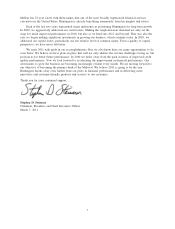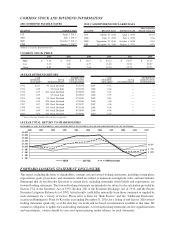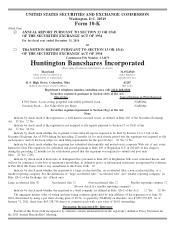Huntington National Bank 2010 Annual Report Download - page 18
Download and view the complete annual report
Please find page 18 of the 2010 Huntington National Bank annual report below. You can navigate through the pages in the report by either clicking on the pages listed below, or by using the keyword search tool below to find specific information within the annual report.
Regulatory Matters
General
We are a bank holding company and are qualified as a financial holding company with the Federal
Reserve. We are subject to examination and supervision by the Federal Reserve pursuant to the Bank Holding
Company Act. We are required to file reports and other information regarding our business operations and the
business operations of our subsidiaries with the Federal Reserve.
Because we are a public company, we are also subject to regulation by the SEC. The SEC has established
four categories of issuers for the purpose of filing periodic and annual reports. Under these regulations, we are
considered to be a large accelerated filer and, as such, must comply with SEC accelerated reporting
requirements.
The Bank, which is chartered by the OCC, is a national bank, and our only bank subsidiary. In addition,
we have numerous nonbank subsidiaries. Exhibit 21.1 of this Form 10-K lists all of our subsidiaries. The Bank
is subject to examination and supervision by the OCC. Its domestic deposits are insured by the DIF of the
FDIC, which also has certain regulatory and supervisory authority over it. Our nonbank subsidiaries are also
subject to examination and supervision by the Federal Reserve or, in the case of nonbank subsidiaries of the
Bank, by the OCC. Our subsidiaries are subject to examination by other federal and state agencies, including,
in the case of certain securities and investment management activities, regulation by the SEC and the Financial
Industry Regulatory Authority.
In connection with EESA, we sold TARP Capital and a warrant to purchase shares of common stock to
the Treasury pursuant to the CPP under TARP. As a result of our participation in TARP, we were subject to
certain restrictions and direct oversight by the Treasury. Upon our repurchase of the TARP Capital on
December 22, 2010, we are no longer subject to the TARP-related restrictions on dividends, stock repurchases,
or executive compensation.
Legislative and regulatory reforms continue to have significant impacts throughout the financial services
industry. In July 2010, the Dodd-Frank Act was enacted. The Dodd-Frank Act, which is complex and broad in
scope, establishes the CFPB, which will have extensive regulatory and enforcement powers over consumer
financial products and services, and the Financial Stability Oversight Council, which has oversight authority
for monitoring and regulating systemic risk. In addition, the Dodd-Frank Act alters the authority and duties of
the federal banking and securities regulatory agencies, implements certain corporate governance requirements
for all public companies including financial institutions with regard to executive compensation, proxy access
by shareholders, and certain whistleblower provisions, and restricts certain proprietary trading and hedge fund
and private equity activities of banks and their affiliates. The Dodd-Frank Act also requires the issuance of
many implementing regulations which will take effect over several years, making it difficult to anticipate the
overall impact to us, our customers, or the financial industry more generally. While the overall impact cannot
be predicted with any degree of certainty, we believe we are likely to be negatively impacted by the Dodd-
Frank Act primarily in the areas of capital requirements, restrictions on fees, and other charges to customers.
In addition to the impact of federal and state regulation, the Bank and our nonbank subsidiaries are
affected significantly by the actions of the Federal Reserve as it attempts to control the money supply and
credit availability in order to influence the economy.
As a bank holding company, we must act as a source of financial and managerial strength to the Bank
and the Bank is subject to affiliate transaction restrictions.
Under changes made by the Dodd-Frank Act, a bank holding company must act as a source of financial
and managerial strength to each of its subsidiary banks and to commit resources to support each such
subsidiary bank. Under current federal law, the Federal Reserve may require a bank holding company to make
capital injections into a troubled subsidiary bank. It may charge the bank holding company with engaging in
unsafe and unsound practices if the bank holding company fails to commit resources to such a subsidiary bank
or if it undertakes actions that the Federal Reserve believes might jeopardize the bank holding company’s
ability to commit resources to such subsidiary bank.
4
























